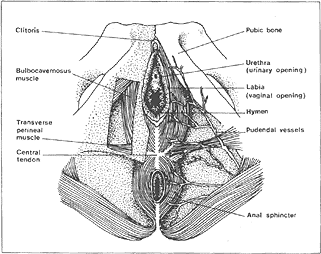What is the “pelvic floor”?

The pelvic floor is a complex, multilayered group of muscles and surrounding tissue that is suspended like a hammock between your pubic bone in front (near your clitoris) and the base of your spinal column in back (near your anus). The illustration below shows the parts of the pelvic floor.
The pelvic floor supports your bladder, rectum, uterus and other internal organs. Bands of pelvic floor muscles are around your vagina, your anus and the tube that carries urine from your bladder (urethra). The tissue between your vagina and anus is called your perineum.
What is “pelvic floor dysfunction”?
Pelvic floor dysfunction describes problems that can happen when your pelvic floor muscles are weakened or injured. A healthy pelvic floor keeps the pelvic organs in their proper place and ensures that the muscles that close the bladder and anus work normally. When the pelvic floor is weakened or injured, a few problems can occur, including:
- Prolapse, when the uterus or other organs may sag.
- Urinary stress incontinence, when urine leaks out with exertion, for example, while coughing, laughing, sneezing or lifting a heavy object.
- Urinary urge incontinence, when urine leaks too early when one is thinking about or getting ready to release it.
- Lower sexual satisfaction during intercourse, because good sex for both partners often depends on good tone in the muscles surrounding the vagina.
- Bowel incontinence, when there is leaking gas, a sense of urgency to use the bathroom or, less commonly, leaking feces.
Childbirth is not the only thing that affects pelvic floor strength. For example, heavy women are much more likely to experience urinary stress incontinence than women who are at average or below-average weight for their height. Smoking (probably because it leads to excess coughing), the use of hormone replacement therapy (HRT) and having a hysterectomy (surgical removal of the uterus) can also weaken the pelvic floor.
How do pregnancy and birth affect the pelvic floor?
Some women experience new or worsened urinary incontinence symptoms during pregnancy and after birth. The excess weight and loosening of tissues (from the hormone Relaxin, which makes it easier for the baby to move through the pelvis) play a role. Fortunately, many of these problems go away during the recovery period in the weeks and months after birth. Read more about the relationship between birth and pelvic floor problems on the Research and Evidence page.


